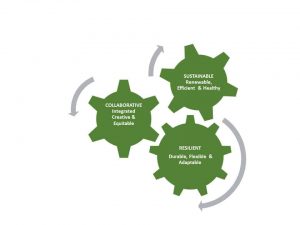by Susan Pranger
For 50 years, the green building movement has focused on reducing the use of limited resources and the negative impacts on global health. A LEED-certified building will “save money and resources and have a positive impact on the health of occupants, while promoting renewable, clean energy”[1]. Smart Growth[2] and New Urbanism[3] encourage communities to use fewer resources by being more dense, transit-oriented, and providing integrated services.
Unfortunately, these efforts have not stopped global warming.[4] Buildings must become more resilient, able to resist and recover from climate changes that are irreversible, escalating, and unpredictable. Resiliency strategies focus on minimizing the impact of predictable changes (increases in temperature, humidity, or sea level) and increasing the ability to recover from extreme events, such as Hurricane Sandy or Boston’s 2015 winter.
For some, a resilient building is one that is self-sufficient — super-insulated, self-powered, off the grid. However, isolating every building is not possible nor is it the best use of resources. Resiliency and sufficiency must occur on a larger scale, which requires creativity, collaboration, and courage.
Resiliency starts with preventive action: Well-maintained, durable buildings can better withstand chronic problems, such as local flooding, deterioration of wood and plastics from increased UVB and temperature, increased insect damage as habitats expand, and increased freeze thaw damage in masonry from prolonged precipitation combined with rapid temperature swings.
Preparing for the impacts of sea level rise, severe drought and extreme storms will force us to look to regional solutions. The threat of flooding has prompted regional planning from neighborhoods as diverse as lower Manhattan[5] and Cedar Rapids, Iowa[6]. These plans are based on technical solutions but shaped by the values of the community.
Strong communities are ecosystems that must be diverse and connected. During The National Trust for Historic Preservation’s session “preservationURBAN,” the panel discussed the dangers of monocultures as our cities grow. Protecting established connections to people and businesses while building new ones is as important to building a resilient community as are the buildings.[7]
Resiliency requires identifying vulnerabilities (Will your elderly neighbor need help in a power outage?) and coordinating resources (Who has an emergency generator?). The response of the Red Hook Initiative to Hurricane Sandy showed that a neighborhood with strong social ties can recover more readily. However, it also “highlighted a lack of coordinated disaster planning and response.” [8]
Building a resilient community is key to our survival and will require an unprecedented level of global communication and cooperation. The Department of Defense is now “integrating climate-related impacts into their planning” because climate change, by increasing droughts and water shortages, can “threaten the stability” of fragile countries, posing “a threat to national security”.[9] Dutch companies that normally compete are also collaborating through “a research consortium that is testing new flood-protection solutions in the Netherlands.”[10] In Boston, the Council General of the Netherlands is collaborating with the Boston Architectural College, Boston Harbor Association, and A Better City to share lessons learned.
At first blush, the challenges seem overwhelming, but I am encouraged by the increasing level of collaboration among architects, engineers, planners, builders, and others who are exploring innovative ways to create a more flexible, resilient future for people and for the planet.
Susan Pranger, AIA, LEED BD+C, is a member of the Boston Landmark Commission and Adjunct Faculty at the Boston Architectural College.
1 USGBC. LEED, 2015 (http://www.usgbc.org/leed).
2 Smart Growth America, “What is Smart Growth?” (http://www.smartgrowthamerica.org/what-is-smart-growth).
3 New Urbanism. “Principles of New Urbanism” ( http://www.newurbanism.org/newurbanism/principles.html).
4 Union of Concerned Scientists, “Global Warming” (http://www.ucsusa.org/our-work/global-warming/science-and-impacts/global-warming-science#.VkDCOjZdFPY).
5 Rebuild by Design, “The Big U” (http://www.rebuildbydesign.org/project/big-team-final-proposal/).
6 Sasaki, “Cedar Rapids Riverfront” (http://www.sasaki.com/project/133/cedar-rapids-riverfront/).
7 Marimba Milliones, “TrustLive: preservationURBAN,” National Trust for Historic Preservation conference, 2015 (www.pastforwardconference.org/session/trustlive-preservationurban).
8 Schmeltz, Michael T. et al.,“Lessons from Hurricane Sandy: A Community Response in Brooklyn, New York,” Journal of Urban Health: Bulletin of the New York Academy of Medicine 90.5 (2013): 799–809. PMC. Web. 9 Nov. 2015 (http://www.ncbi.nlm.nih.gov/pmc/articles/PMC3795193/).
9 US Department of Defense, “DoD Releases Report on Security Implications of Climate Change” 2015 (http://www.defense.gov/News-Article-View/Article/612710).
10 Jeff Chu, “ How the Netherlands became the biggest exporter of resilience” FastCompany (http://www.fastcoexist.com/3020918/how-the-netherlands-became-the-biggest-exporter-of-resilience#2).












